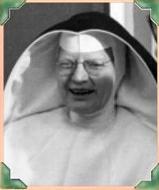
 |
| HOME | NEWS | MEETINGS | EDUCATION | ACTIVITIES | CONTACT US |
|---|
Sr. Alberic Runde
Chemistry Educator (1903 - 1960)
 Mabel
Runde was born in 1903 in rural southwestern Wisconsin, the fourth of ten children
of August and Louisa Runde, who farmed at Sinsinawa (near Galena). Her grandparents
had settled in “the western wilds” during the
mid-1800s. Mabel obtained her AB degree in chemistry at Rosary College (now
Dominican University) in River Forest, Illinois. Her official transcript gives
the “date of leaving” for Alberic Runde as June 1924. Mabel’s
name had been changed to Alberic—a variation on St. Albert the Great—upon
her entrance into the Dominican Order of religious sisters.
Mabel
Runde was born in 1903 in rural southwestern Wisconsin, the fourth of ten children
of August and Louisa Runde, who farmed at Sinsinawa (near Galena). Her grandparents
had settled in “the western wilds” during the
mid-1800s. Mabel obtained her AB degree in chemistry at Rosary College (now
Dominican University) in River Forest, Illinois. Her official transcript gives
the “date of leaving” for Alberic Runde as June 1924. Mabel’s
name had been changed to Alberic—a variation on St. Albert the Great—upon
her entrance into the Dominican Order of religious sisters.
Sr. Alberic then pursued a masters degree in chemistry at the University of Illinois at Urbana-Champaign, graduating in 1927. Her advisor was John (Jack) Raven Johnson, a chemistry instructor who later joined the faculty at Cornell. She was listed as first author on a 1930 publication in JACS entitled “Rearrangement of the Alpha-Furfuryl Group. 2-Furylacetic Acid and 5-Methylfuroic Acid”. The authors note that this area of research was made possible by the recent “availability of pure furfural in large amounts.” Alberic became friends with professors Roger Adams and Carl S. (Speed) Marvel, and also with Carl Moore (Loyola, emeritus), and she would have known William Albert Noyes, head of the department from 1907–1926. The Chemistry Building (later renamed Noyes Laboratory) had been outfitted in 1916 with the unique features of ventilation and electric wall plugs.
Sr. Alberic began teaching chemistry at Rosary College in 1928 and remained on the faculty there for the next 32 years. She also worked on her doctorate at Yale University, probably during the summers, performing research in the area of synthetic organic chemistry on pharmacologically interesting compounds. Her thesis was entitled “The Synthesis of Some Homologues and Analogues of Cinchophen” — the drug cinchophen (2-phenylquinoline-4-carboxylic acid) had been introduced in 1910 as a treatment for gout. Alberic was later to teach a course called “Synthetic Medicinals”, no doubt inspired by her Yale experience. Of the 420 PhD degrees awarded in the United States in chemistry for 1932, Yale awarded 16, with four going to women.
By all accounts, Sr. Alberic Runde was an outstandingly good chemistry educator and humanist. “She was such an excellent teacher—It made all the difference in my life,” relates Sr. Mary Woods, a student of Sr. Alberic in the 1940s. “She would sit in her second-floor office, which she called ‘the hutch’, surrounded by many stacks of reading material on the floor—Fortune magazine, Newsweek, books of poetry and philosophy, and chemical society journals. She inspired me with her all-encompassing curiosity.” A few recent events also highlight Sr. Alberic’s enduring legacy. In 2000, former chemistry student Ida Brechtel, MD left as a lasting tribute a $3.2 million gift to be used for science scholarships. In 2004, Dominican University named a service-learning suite in Centennial Hall after Sr. Alberic in recognition of her life-long devotion “to serving and strengthening the world and the academic institution (she) knew as Rosary College.”
Special thanks to Sr. Mary Woods, ACS member emerita, for her oral history contributions to this article.
– Written by Margaret E. Schott
| Last updated 2/28/10 Copyright © 2009-2010, Chicago Section, The American Chemical Society |
Webs by Wizardcraft |